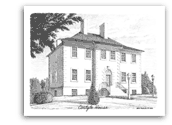Carlyle
House
Alexandria, Virginia
#NC-06110-HM - Notecards
Also available in Assortment Pack #AST-710
#PR-06110-HM
- Open Edition Print
Carlyle House
was built in 1752 by Scottish merchant John Carlyle. It is unique
to Alexandria for its grand mid-Georgian style architecture and
stone block construction.
During the
French and Indian War, Major General Edward Braddock used Carlyle
House as his Alexandria headquarters. It was here that he met
with five royal governors on 14 April 1755. They were summoned
by Braddock to discuss military strategy and methods of funding
the war. Conditions arising from the French and Indian War helped
set the stage for the American Revolution.
In the mid-nineteenth
century, Carlyle House became part of a hotel complex owned by
James Green, a local furniture manufacturer. After his death in
1880, the property went through a period of slow decline. Northern
Virginia Regional Park Authority purchased Carlyle House in 1970.
It was opened to the public in 1976 after a six-year period of
restoration.
Text
© 1995 Dianne Harrah, Drawing © 1995 Bill Harrah
|

|
|
Copyright
Notice
Drawings Copyright © 1992-2010 Bill Harrah, Wolf Run Studio (SM), All Rights
Reserved. Wolf Run Studio is a service mark of Bill Harrah and has been in continuous use since 1992. All of the images on this website are in tangible form and are fully
copyrighted. Each has an invisible digital identification which is traceable
through the Digimarc Corporation. Viewers of the Wolf Run Studio website are
allowed to browse and print out images for personal, non-commercial use only.
You may not distribute copies of images or image files to anyone else for any
reason. Images may not be reproduced or used in any form or any manner, or displayed
on any website without the express written consent of Bill
Harrah.
Text Copyright
© 1992-2010
Terry White or
Dianne Harrah. Text on this website is used with permission from the authors.
Viewers of the Wolf Run Studio website are allowed to browse and print out text
for personal, non-commercial use only. Text may not be reproduced or used in any
form or any manner without the express written consent of the authors.
Information
Accuracy
The information for the written description of each location has been carefully
researched by the authors and is believed to be accurate. New findings, however,
could make some information out-of-date. If you are a professional historian,
archaeologist, or architect, and have new information that you are willing to
share, please contact
Dianne Harrah
.
|



